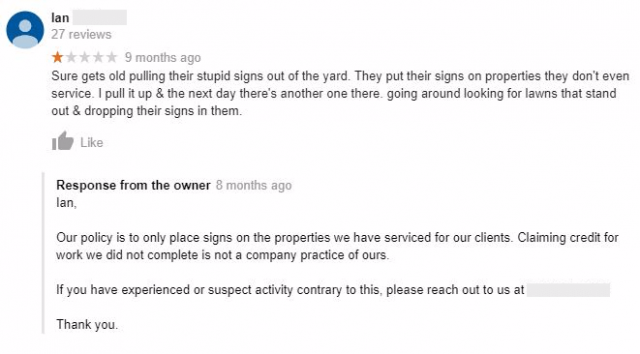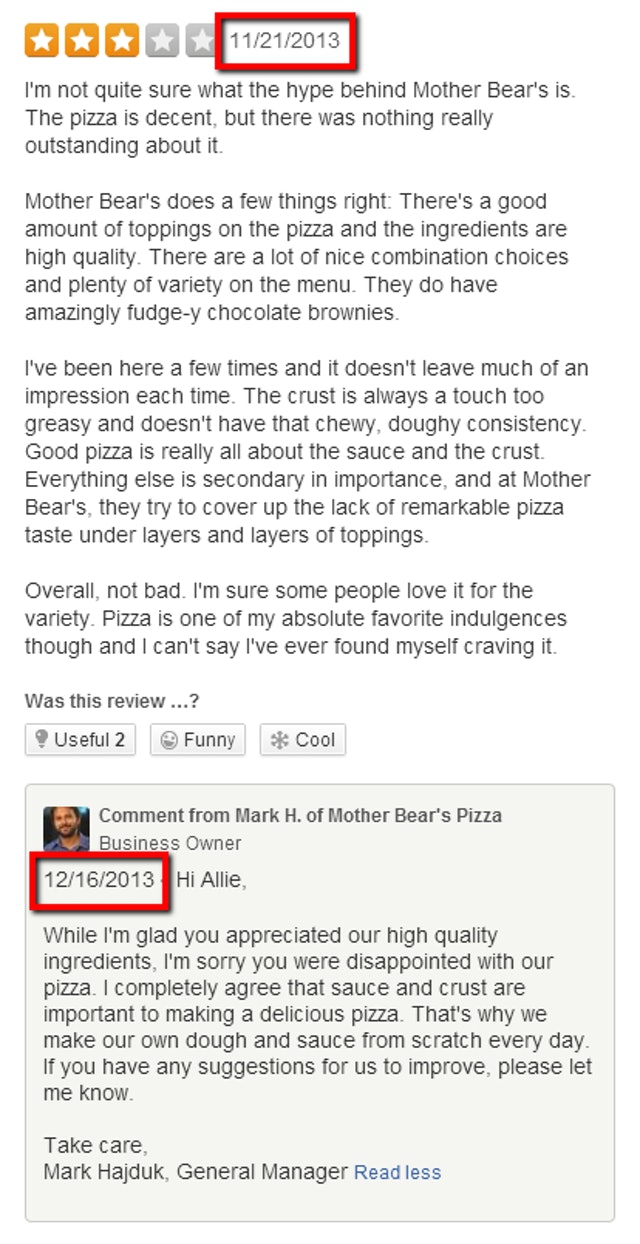[ad_1]
Reviews assist consumers in making quick decisions about purchases in their research by providing a clear picture of your company. Studies show that of businesses who respond to bad reviews, 33% turn around and post a good review, and 34% delete the original negative review. Whether a review is good or bad, it makes sense to respond, but how?
When responding to negative reviews, one of the best responses is simply asking for more information and trying to find out what went wrong.
Despite your natural feeling of frustration, make your best effort to remedy the situation. Resolve the problem by apologizing and repairing it. If you resolve the issue, many customers will be happy to change their reviews.
Below I’ll run through steps covering how to respond to negative reviews online.
1. Keep calm and take a breath
It can be hard not to take personal insults and low-star ratings as being directed at us, but it is important to remember that sometimes people are venting their frustrations about something else. A good way of responding to a negative reivew might be to thank them for taking the time—yes, even if they didn’t like your business or service—and to ask what could have been done better in order to make things right with them.
Before responding to a negative review, take a moment to breathe deeply and think about it. If necessary, get up and walk around the block. The best thing to do is to settle your emotions before responding, as being angry with a customer is never a good outcome.
You might find it helpful to have a list of standard responses to refer to when responding to a customer who’s had a bad experience. In writing a reply to the reviewer, you can use these “canned” responses as a starting point. Then tailor your canned responses to each reviewer’s feedback to ensure people reading your reviewers don’t see too much repetition.
Taking a moment to think about what you want to say, or the kind of response you want to use, can be incredibly helpful—especially if you’re upset.
Take the below response, for example. If emotions had been settled before responding, the responder might have delivered a better response, without the sarcasm. It would have been better to look at this situation from the perspective of asking if anything could have been done better to make things right with the reviewer.

2. Remember that you must respond to negative reviews
Bad reviews actually have the power to improve conversion rates, so it would be a shame not to take this golden opportunity to respond. Taking the time to respond to a negative review can result in a 16% boost in customer advocacy.
Remember that the most effective form of marketing is word of mouth. Businesses experience a 37% decline in customer advocacy simply by the act of not responding to negative reviews.
Be empathetic in your approach. Reviewers often just want to be heard. Sometimes, all it takes to make a customer happy is to show them that you have heard them and that you want to solve their problem. Customer satisfaction can be doubled by resolving a customer issue in a single contact, as you’re far more likely to get a repeat sale.
Over 70% of buying decisions are based on how a customer feels they are being treated, so do your best to make all of your customers feel valued – even the unhappy ones, as below.

3. Consider the type of reviewer you’re dealing with
There are many different types of reviews and reviewers, but there are a few categories into which most people fall. You’re guaranteed to make the response process faster and more effective if you take advantage of BrightLocal’s tips on different types of reviewers, like first-time, sharpshooters, and serial complainers, for example.
First-time reviewers: Consider whether the negative feedback is accurate. If it is, make internal changes to remedy the problem. When applicable, explain how you will prevent this issue from occurring again in the future. Also, if you disagree with the reviewer’s assertions, politely and professionally present your point of view.
Sharpshooters: When dealing with a short, confident review from an expert, keep in mind that brevity is the goal. Condense your response into clear and concise sentences rather than lengthy ones to better reflect this type of reviewer’s communication style.
Serial Complainers: The serial complainer can really hurt your business, so tread carefully. These reviewers have experience with similar businesses and know how to make them look bad in the process. To avoid this, take note of what other companies did when responding with them as well as avoiding making mistakes they made!
Top Tip: If you’re need to respond to Google reviews, click on the reviewer’s profile and you should be able to say all the reviews they’ve left for other businesses. Looking at how other businesses have responded to these reviews (and how successful they’ve been in turning the reviewer around) will give you a great idea of how to approach their review of your business.
4. Resolve the issue
Sometimes customers leave reviews because they are disappointed or disgruntled, and not because of something you’ve done. If possible, try contacting them privately with a response that politely addresses their message.
Work to solve the problem with more than just a response. Discover what went wrong and why the reviewer was so dissatisfied. Search your database for their email or phone number and contact them. Instead of addressing the issue online, you’ll be able to speak directly and resolve it “in person.”
Efforts to resolve the problem show the customer (and others) you mean business. When customer trust is broken, it is critical to go the extra mile. Fixing the problem not only makes the customer happier, but other potential clients will see how important your customers are to your business, as you can see below.

5. Get a second opinion
Though it’s tempting to jump into defending yourself against unjustified complaints, responding with anger will do more harm than good. Responding in an informative manner, that acknowledges the customer’s frustration, will help you to avoid escalating any unnecessary problems.
To ensure that your response to a bad review is accurate, let an impartial third party read it before you post it online. Double-check your message and tone by sending the response to several colleagues to ensure that it “reads” well to a third party. This is important because your response may be interpreted as overly defensive or aggressive, and this would not help to win over the customer.
Share an example of what you have written with friends, family, and/or a private business network. Be transparent and open with the feedback you receive and make adjustments accordingly.
6. Remember that a well-written negative review response can increase sales
Look at the positive within the negative. Negative reviews will stay negative forever if you do not respond, and we all know that nothing is lost on the Internet. How you respond to negative reviews can provide consumers with insight into your business’ credibility.
In addition to fixing problems raised by negative reviews, there is another benefit. You gain the trust of potential customers. If you fix your mistakes, they will see that you are thorough and responsible, and that is certainly something to be valued as a business.
This is a good time to gain insight into what your company may be doing wrong. Seeing the potential hidden within a negative review may help you improve your business. Look at the review and carefully consider what the person wrote.:
- Did they have a problem with a staff member?
- What was their experience like at your location?
- Has your product or service failed to meet their expectations?
In analyzing what the customer says, look for larger issues that need to be addressed at your business, as in the example below.

7. Take the discussion offline
On the other hand, negative feedback can provide a wealth of useful information, because what your product or service lacks is sometimes more obvious to your customers than you.
Have you ever tried to collect customer surveys to get this information? A task of this nature is near-impossible. Although people may sincerely want to answer all the questions, sometimes they just forget about it when the daily rush gets to them. So reviews give you a lot of valuable feedback in this respect.
Additionally, this type of feedback gives you time to resolve issues before the problem escalates with other customers. The best cure is prevention. Your customers know better than anyone what is missing from your product, so pay extra attention to what they have to say.
According to Harris Interactive, 75% of customers believe it takes too long to reach a live agent on the phone. Increasingly, people use online reviews, social media, and other online methods for customer service and to voice their opinion publicly since it gets higher attention.
The best way to handle attention-seeking people is to take the discussion offline as soon as possible. Simply let the customer know you heard them, like the example below, and then ask them to call or email you personally so you can resolve the matter.

8. Ask for a do-over
As long as you’ve taken steps to resolve the situation with an unhappy customer, you shouldn’t hesitate to politely request that they update/change their review to reflect the resolution.
One of the best ways to do this is to send an email outlining what happened, what you resolved, and the steps you’re taking to improve things going forward, and then politely asking if they would mind updating their review.

9. Get more positive reviews to push down the negative reviews
The vast majority of people read an average of 10 reviews before they decide to use a business. The review process is usually ordered chronologically, so if you keep a steady stream of positive reviews flowing in, you will see those negative ones extinguish over time.
The best way to counteract one negative review is to get a few more positive reviews to “push down” the negative review. Provide an easy way for your customers to write positive reviews (and respond to Google reviews) about your business.
Your business is worth a searcher’s time when it has online reviews. Easily and quickly create a steady stream of positive customer reviews for your company with Brightlocal’s Get Reviews tool.
10. Respond in a timely manner
The clock begins ticking once reviews are posted. In the below example, the response was almost one month later and customers expect to hear back from you within 24 hours.

It’s important to respond seriously to negative reviews of your company, especially if the customer felt dissatisfied enough to write one.
Responding to negative reviews is a perfect example of the phrase “time is money”. Take note of any negative feedback when it appears on your radar and begin to formulate a response immediately. You can begin with an explanation that states, “We understand your concerns and are investigating the situation to determine how we can best address them. If you give us 24 hours, we will get back to you.” Follow up on your review by editing it and explaining what you’ve discovered and what’s next.
11. Identify and respond to fake reviews, too
Handling negative reviews with grace is a key to online reputation success. It’s important to understand how customers feel about your business online but to also be aware of who left a review. Occasionally a review can come from an ex-employee, a competitor or it can be fake. (Check out the obviously fake review in the image below).
It is important to understand the guidelines for each platform in order to know what can be flagged and how. The links below can you help you better identify how to proceed.

Your opinion matters
In conclusion, I have a couple of questions for you: what tool are you using to monitor your online reviews, and when dealing with unhappy customers, what steps do you take? Please comment below and let us know.
[ad_2]
Source link
